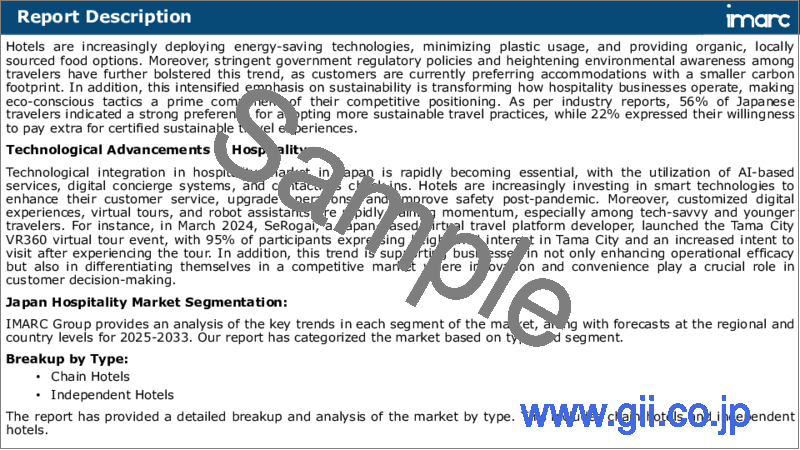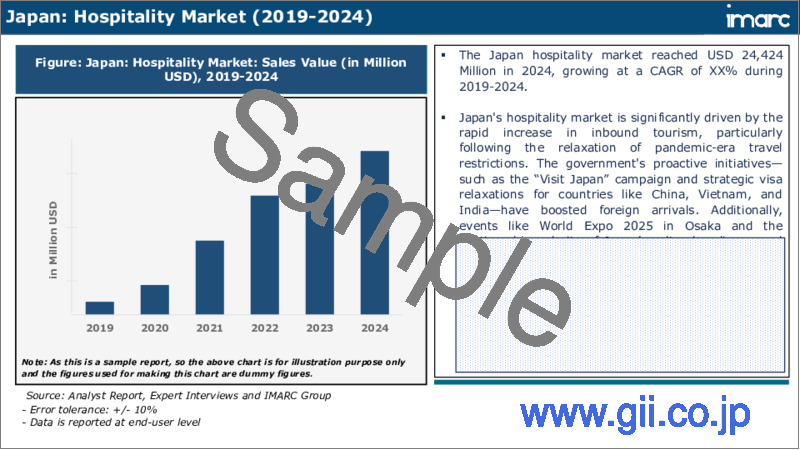|
|
市場調査レポート
商品コード
1729557
日本のホスピタリティ市場レポート:タイプ、セグメント、地域別、2025年~2033年Japan Hospitality Market Report by Type (Chain Hotels, Independent Hotels), Segment (Service Apartments, Budget and Economy Hotels, Mid and Upper Mid-Scale Hotels, Luxury Hotels), and Region 2025-2033 |
||||||
カスタマイズ可能
|
|||||||
| 日本のホスピタリティ市場レポート:タイプ、セグメント、地域別、2025年~2033年 |
|
出版日: 2025年05月01日
発行: IMARC
ページ情報: 英文 121 Pages
納期: 5~7営業日
|
全表示
- 概要
- 目次
日本のホスピタリティの市場規模は2024年に244億米ドルに達しました。IMARC Groupは、2025年から2033年にかけての成長率(CAGR)は1%で、2033年には270億米ドルに達すると予測しています。個人の生活水準の向上と、週末文化やステイケーションの人気の高まりが、主に市場成長の原動力となっています。
本レポートで扱う主な質問
- 日本のホスピタリティ市場はこれまでどのように推移してきたか?
- COVID-19が日本のホスピタリティ市場に与えた影響は?
- 日本のホスピタリティ市場のタイプ別区分は?
- 日本のホスピタリティ市場のセグメント区分は?
- 日本のホスピタリティ市場のバリューチェーンにおける様々なステージとは?
- 日本のホスピタリティ市場の主な促進要因と課題は?
- 日本のホスピタリティ市場の構造と主要プレーヤーは?
- 日本のホスピタリティ市場における競合の程度は?
目次
第1章 序文
第2章 調査範囲と調査手法
- 調査の目的
- ステークホルダー
- データソース
- 市場推定
- 調査手法
第3章 エグゼクティブサマリー
第4章 日本のホスピタリティ市場:イントロダクション
- 概要
- 市場力学
- 業界動向
- 競合情報
第5章 日本のホスピタリティ市場情勢
- 過去および現在の市場動向(2019~2024年)
- 市場予測(2025~2033年)
第6章 日本のホスピタリティ市場:タイプ別内訳
- チェーンホテル
- 独立系ホテル
第7章 日本のホスピタリティ市場:セグメント別内訳
- サービスアパートメント
- 格安ホテルとエコノミーホテル
- ミドルおよびアッパーミドル規模のホテル
- ラグジュアリーホテル
第8章 日本のホスピタリティ市場:競合情勢
- 概要
- 市場構造
- 市場企業のポジショニング
- 主要成功戦略
- 競合ダッシュボード
- 企業評価象限
第9章 主要企業のプロファイル
第10章 日本のホスピタリティ市場:業界分析
- 促進要因、抑制要因、機会
- ポーターのファイブフォース分析
- バリューチェーン分析
第11章 付録
Japan hospitality market size reached USD 24.4 Billion in 2024. Looking forward, IMARC Group expects the market to reach USD 27.0 Billion by 2033, exhibiting a growth rate (CAGR) of 1% during 2025-2033. The improving living standards of individuals, coupled with the increasing popularity of weekend cultures and staycations, are primarily driving the market growth.
The hospitality industry is a multifaceted and dynamic sector, playing a crucial role in economies globally. It encompasses a spectrum of services, including accommodation, food and beverage, travel, tourism, and recreational activities, each focused on delivering superior customer experiences. This industry stands distinct due to its relentless commitment to customer satisfaction and its capacity to create memorable experiences. It operates in an environment marked by constant evolution, driven by shifts in consumer preferences, technological innovations, and global trends. Today, the significance of technology and sustainable practices is profoundly impacting the sector, paving the way for enhanced service delivery and responsible operations. The integration of digital solutions and green initiatives is shaping the industry's future, responding to the modern consumer's desire for convenience and eco-consciousness. Overall, the hospitality industry is a vibrant realm, harmonizing traditional values of service with contemporary advancements to meet evolving demands.
Japan Hospitality Market Trends:
Increase in Domestic Tourism
Domestic tourism has become a critical driver of the Japan hospitality industry, majorly fueled by beneficial government initiatives and the magnifying popularity of local cultural experiences. Travelers are increasingly exploring rural destinations, resulting in an elevated demand for regional accommodations, such as local resorts and traditional ryokan inns. Moreover, this trend gained traction during the pandemic as international travel restrictions stimulated an inclination towards domestic vacations. As a result, occupancy rates have substantially risen in domestic tourist spots, with customers continuing to focus on convenience, safety, and culturally immersive experiences when choosing their travel destinations. As per industry reports, the estimated number of Japanese domestic travelers is anticipated to reach 273 million in the year 2024.
Sustainability and Eco-Friendly Accommodations
The Japanese hospitality market is witnessing an escalating demand for eco-friendly and sustainable accommodations, with both global brands and local hotels adopting green practices. Hotels are increasingly deploying energy-saving technologies, minimizing plastic usage, and providing organic, locally sourced food options. Moreover, stringent government regulatory policies and heightening environmental awareness among travelers have further bolstered this trend, as customers are currently preferring accommodations with a smaller carbon footprint. In addition, this intensified emphasis on sustainability is transforming how hospitality businesses operate, making eco-conscious tactics a prime component of their competitive positioning. As per industry reports, 56% of Japanese travelers indicated a strong preference for adopting more sustainable travel practices, while 22% expressed their willingness to pay extra for certified sustainable travel experiences.
Technological Advancements in Hospitality
Technological integration in hospitality market in Japan is rapidly becoming essential, with the utilization of AI-based services, digital concierge systems, and contactless check-ins. Hotels are increasingly investing in smart technologies to enhance their customer service, upgrade operations, and improve safety post-pandemic. Moreover, customized digital experiences, virtual tours, and robot assistants are rapidly gaining momentum, especially among tech-savvy and younger travelers. For instance, in March 2024, SeRogai, a Japan-based virtual travel platform developer, launched the Tama City VR360 virtual tour event, with 95% of participants expressing heightened interest in Tama City and an increased intent to visit after experiencing the tour. In addition, this trend is supporting businesses in not only enhancing operational efficacy but also in differentiating themselves in a competitive market where innovation and convenience play a crucial role in customer decision-making.
Japan Hospitality Market Segmentation:
Breakup by Type:
- Chain Hotels
- Independent Hotels
Breakup by Segment:
- Service Apartments
- Budget and Economy Hotels
- Mid and Upper Mid-scale Hotels
- Luxury Hotels
Competitive Landscape:
The market research report has also provided a comprehensive analysis of the competitive landscape. Competitive analysis such as market structure, key player positioning, top winning strategies, competitive dashboard, and company evaluation quadrant has been covered in the report. Also, detailed profiles of all major companies have been provided. Some of the key players include:
- APA Hotels & Resorts
- JR Hotel Group
- Marriott International Inc.
- MYSTAYS Hotel Group
- Okura Nikko Hotel Management Co. Ltd.
- Prince Hotels & Resorts
- Route Inn Japan Co. Ltd.
- Super Hotel Co. Ltd.
- Tokyu Hotels & Resorts Co. Ltd.
- Toyoko Inn Co. Ltd.
Japan Hospitality Market News:
- In August 2024, NOT A HOTEL, a Japanese hospitality startup, announced a strategic expansion in the country, encompassing four new flagship properties in Rusutsu, Setouchi, Miura, and Tokyo.
- In April 2024, Six Senses, a prominent resort and hotel company, announced its launch in Kyoto, Japan, and a significant addition to its proliferating urban portfolio. This luxury Kyoto hotel includes 81 suites and guest rooms, providing sustainable practices, holistic wellness, and unique experiences to its guests.
Key Questions Answered in This Report:
- How has the Japan hospitality market performed so far and how will it perform in the coming years?
- What has been the impact of COVID-19 on the Japan hospitality market?
- What is the breakup of the Japan hospitality market on the basis of type?
- What is the breakup of the Japan hospitality market on the basis of segment?
- What are the various stages in the value chain of the Japan hospitality market?
- What are the key driving factors and challenges in the Japan hospitality market?
- What is the structure of the Japan hospitality market and who are the key players?
- What is the degree of competition in the Japan hospitality market?
Table of Contents
1 Preface
2 Scope and Methodology
- 2.1 Objectives of the Study
- 2.2 Stakeholders
- 2.3 Data Sources
- 2.3.1 Primary Sources
- 2.3.2 Secondary Sources
- 2.4 Market Estimation
- 2.4.1 Bottom-Up Approach
- 2.4.2 Top-Down Approach
- 2.5 Forecasting Methodology
3 Executive Summary
4 Japan Hospitality Market - Introduction
- 4.1 Overview
- 4.2 Market Dynamics
- 4.3 Industry Trends
- 4.4 Competitive Intelligence
5 Japan Hospitality Market Landscape
- 5.1 Historical and Current Market Trends (2019-2024)
- 5.2 Market Forecast (2025-2033)
6 Japan Hospitality Market - Breakup by Type
- 6.1 Chain Hotels
- 6.1.1 Overview
- 6.1.2 Historical and Current Market Trends (2019-2024)
- 6.1.3 Market Forecast (2025-2033)
- 6.2 Independent Hotels
- 6.2.1 Overview
- 6.2.2 Historical and Current Market Trends (2019-2024)
- 6.2.3 Market Forecast (2025-2033)
7 Japan Hospitality Market - Breakup by Segment
- 7.1 Service Apartments
- 7.1.1 Overview
- 7.1.2 Historical and Current Market Trends (2019-2024)
- 7.1.3 Market Forecast (2025-2033)
- 7.2 Budget and Economy Hotels
- 7.2.1 Overview
- 7.2.2 Historical and Current Market Trends (2019-2024)
- 7.2.3 Market Forecast (2025-2033)
- 7.3 Mid and Upper Mid-scale Hotels
- 7.3.1 Overview
- 7.3.2 Historical and Current Market Trends (2019-2024)
- 7.3.3 Market Forecast (2025-2033)
- 7.4 Luxury Hotels
- 7.4.1 Overview
- 7.4.2 Historical and Current Market Trends (2019-2024)
- 7.4.3 Market Forecast (2025-2033)
8 Japan Hospitality Market - Competitive Landscape
- 8.1 Overview
- 8.2 Market Structure
- 8.3 Market Player Positioning
- 8.4 Top Winning Strategies
- 8.5 Competitive Dashboard
- 8.6 Company Evaluation Quadrant
9 Profiles of Key Players
- 9.1 APA Hotels & Resorts
- 9.1.1 Business Overview
- 9.1.2 Services Offered
- 9.1.3 Business Strategies
- 9.1.4 SWOT Analysis
- 9.1.5 Major News and Events
- 9.2 JR Hotel Group
- 9.2.1 Business Overview
- 9.2.2 Services Offered
- 9.2.3 Business Strategies
- 9.2.4 SWOT Analysis
- 9.2.5 Major News and Events
- 9.3 Marriott International Inc.
- 9.3.1 Business Overview
- 9.3.2 Services Offered
- 9.3.3 Business Strategies
- 9.3.4 SWOT Analysis
- 9.3.5 Major News and Events
- 9.4 MYSTAYS Hotel Group
- 9.4.1 Business Overview
- 9.4.2 Services Offered
- 9.4.3 Business Strategies
- 9.4.4 SWOT Analysis
- 9.4.5 Major News and Events
- 9.5 Okura Nikko Hotel Management Co. Ltd.
- 9.5.1 Business Overview
- 9.5.2 Services Offered
- 9.5.3 Business Strategies
- 9.5.4 SWOT Analysis
- 9.5.5 Major News and Events
- 9.6 Prince Hotels & Resorts
- 9.6.1 Business Overview
- 9.6.2 Services Offered
- 9.6.3 Business Strategies
- 9.6.4 SWOT Analysis
- 9.6.5 Major News and Events
- 9.7 Route Inn Japan Co. Ltd.
- 9.7.1 Business Overview
- 9.7.2 Services Offered
- 9.7.3 Business Strategies
- 9.7.4 SWOT Analysis
- 9.7.5 Major News and Events
- 9.8 Super Hotel Co. Ltd.
- 9.8.1 Business Overview
- 9.8.2 Services Offered
- 9.8.3 Business Strategies
- 9.8.4 SWOT Analysis
- 9.8.5 Major News and Events
- 9.8 Tokyu Hotels & Resorts Co. Ltd.
- 9.8.1 Business Overview
- 9.8.2 Services Offered
- 9.8.3 Business Strategies
- 9.8.4 SWOT Analysis
- 9.8.5 Major News and Events
- 9.9 Toyoko Inn Co. Ltd.
- 9.9.1 Business Overview
- 9.9.2 Services Offered
- 9.9.3 Business Strategies
- 9.9.4 SWOT Analysis
- 9.9.5 Major News and Events
10 Japan Hospitality Market - Industry Analysis
- 10.1 Drivers, Restraints and Opportunities
- 10.1.1 Overview
- 10.1.2 Drivers
- 10.1.3 Restraints
- 10.1.4 Opportunities
- 10.2 Porters Five Forces Analysis
- 10.2.1 Overview
- 10.2.2 Bargaining Power of Buyers
- 10.2.3 Bargaining Power of Suppliers
- 10.2.4 Degree of Competition
- 10.2.5 Threat of New Entrants
- 10.2.6 Threat of Substitutes
- 10.3 Value Chain Analysis





